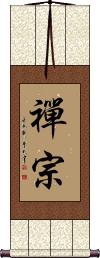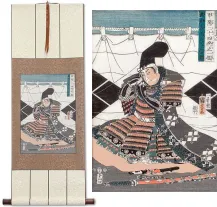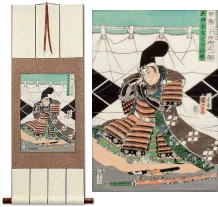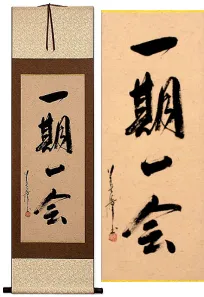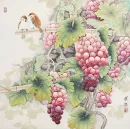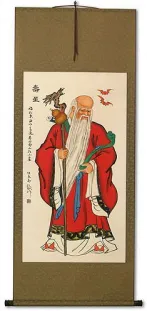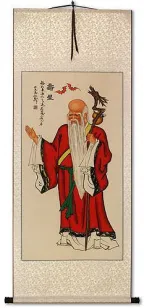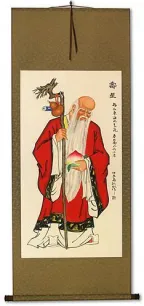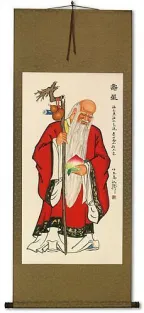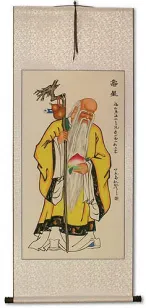Many custom options...
And formats...

Not what you want?
Try other similar-meaning words, fewer words, or just one word.
Feel free to email me with your request. If it's easy, I'll translate it for free and add it to this database of calligraphy for you.
Twenty One in Chinese / Japanese...
Buy a Twenty One calligraphy wall scroll here!
Zen Buddhism
禪宗 is one way to title “Zen Buddhism.” Because the original pronunciation of Zen in Chinese is Chan, you'll also see this expressed as Chan Buddhism.
From the Buddhist Dictionary:
The Chan, meditative or intuitional, sect is usually said to have been established in China by Bodhidharma, the twenty-eighth patriarch, who brought the tradition of the Buddha-mind from India. This sect, believing in direct enlightenment, disregarded ritual and sūtras and depended upon the inner light and personal influence for the propagation of its tenets, founding itself on the esoteric tradition supposed to have been imparted to Kāśyapa by the Buddha, who indicated his meaning by plucking a flower without further explanation. Kāśyapa smiled in apprehension and is supposed to have passed on this mystic method to the patriarchs. The successor of Bodhidharma was 慧可 Huike, and he was succeeded by 僧璨 Sengcan, 道信 Daoxin, 弘忍 Hongren, 慧能 Huineng, and 神秀 Shenxiu, the sect dividing under the two latter into the southern and northern schools: the southern school became prominent, producing 南嶽 Nanyue and 靑原 Qingyuan, the former succeeded by 馬祖 Mazu, the latter by 石頭 Shitou. From Mazu's school arose the five later schools.
This in-stock artwork might be what you are looking for, and ships right away...
Gallery Price: $72.00
Your Price: $39.88
Gallery Price: $108.00
Your Price: $59.88
Gallery Price: $108.00
Your Price: $59.88
Gallery Price: $340.00
Your Price: $188.77
Gallery Price: $61.00
Your Price: $33.88
Gallery Price: $61.00
Your Price: $33.88
Gallery Price: $61.00
Your Price: $33.88
Gallery Price: $61.00
Your Price: $33.88
Gallery Price: $61.00
Your Price: $33.88
Gallery Price: $200.00
Your Price: $79.88
Not the results for twenty one that you were looking for?
Below are some entries from our dictionary that may match your twenty one search...
| Characters If shown, 2nd row is Simp. Chinese |
Pronunciation Romanization |
Simple Dictionary Definition |
參 参 see styles |
shēn shen1 shen shin |
ginseng; one of the 28 constellations Reflect on, counsel, visit superior. An assembly a gathering for the purpose of meditation, preaching, worship. Read shen, the twenty-first constellation, α, β, γ, δ, ε, ζ, η, and k in Orion.; Worship on the four fives, i. e. the fifth, tenth, twentieth, and twenty-fifth days of the month; also ||上堂. |
宗 see styles |
zōng zong1 tsung motoi もとい |
school; sect; purpose; model; ancestor; clan; to take as one's model (in academic or artistic work); classifier for batches, items, cases (medical or legal), reservoirs (1) (rare) origin; source; (2) (rare) virtuous ancestor; (given name) Motoi Ancestors, ancestral; clan; class, category. kind; school, sect; siddhānta, summary, main doctrine, syllogism, proposition, conclusion, realization. Sects are of two kinds: (1) those founded on principles having historic continuity, as the twenty sects of the Hīnayāna, the thirteen sects of China, and the fourteen sects of Japan: (2) those arising from an individual interpretation of the general teaching of Buddhism, as the sub-sects founded by Yongming 永明 (d. 975), 法相宗, 法性宗, 破相宗, or those based on a peculiar interpretation of one of the recognized sects, as the Jōdo-shinshū 淨土眞宗 found by Shinran-shōnin. There are also divisions of five, six, and ten, which have reference to specific doctrinal differences. Cf. 宗派. |
五時 五时 see styles |
wǔ shí wu3 shi2 wu shih goji |
(五時教) The five periods or divisions of Śākyamuni's teaching. According to Tiantai they are (1) 華嚴時 the Avataṃsaka or first period in three divisions each of seven days, after his enlightenment, when he preached the content, of this sutra; (2) 鹿苑時 the twelve years of his preaching the Āgamas 阿含 in the Deer Park; (3) 方等時 the eight years of preaching Mahāyāna-cum-Hīnayāna doctrines, the vaipulya period; (4) 般若時 the twenty-two years of his preaching the prajñā or wisdom sutras; (5) 法華涅槃時 the eight years of his preaching the Lotus Sutra and, in a day and a night, the Nirvana Sutra. According to the Nirvana School (now part of the Tiantai) they are (1) 三乘別教 the period when the differentiated teaching began and the distinction of the three vehicles, as represented by the 四諦 Four Noble Truths for śrāvakas, the 十二因緣 Twelve Nidānas for pratyekabuddhas, and the 六度 Six Pāramitās for bodhisattvas; (2) 三乘通教 the teaching common to all three vehicles, as seen in the 般若經; (3) 抑揚教 the teaching of the 維摩經, the 思益梵天所問經, and other sutras olling the bodhisattva teaching at the expense of that for śrāvakas; (4) 同歸教 the common objective teaching calling all three vehicles, through the Lotus, to union in the one vehicle; (5) 常住教 the teaehmg of eternal life i. e. the revelation through the Nirvana sutra of the eternity of Buddhahood; these five are also called 有相; 無相; 抑揚; 曾三歸—; and 圓常. According to 劉虬 Liu Chiu of the 晉 Chin dynasty, the teaching is divided into 頓 immediate and 漸 gradual attainment, the latter having five divisions called 五時教 similar to those of the Tiantai group. According to 法寶 Fabao of the Tang dynasty the five are (1) 小乘; (2) 般着 or 大乘; (3) 深密 or 三乘; (4) 法華 or 一乘; (5) 涅槃 or 佛性教. |
五法 see styles |
wǔ fǎ wu3 fa3 wu fa gohō |
pañcadharma. The five laws or categories, of which four groups are as follows: I. 相名五法 The five categories of form and name: (1) 相 appearances, or phenomena; (2) 名 their names; (3) 分別 sometimes called 妄想 ordinary mental discrimination of them— (1) and (2) are objective, (3) subjective; (4) 正智 corrective wisdom, which corrects the deficiencies and errors of the last: (5) 如如 the 眞如 Bhutatathata or absolute wisdom, reached through the 如理智 understanding of the law of the absolute, or ultimate truth. II. 事理五法 The five categories into which things and their principles are divided: (1) 心法 mind; (2) 心所法 mental conditions or activities; (3) 色法 the actual states or categories as conceived; (4) 不相應法 hypothetic categories, 唯識 has twenty-four, the Abhidharma fourteen; (5) 無爲法 the state of rest, or the inactive principle pervading all things; the first four are the 事 and the last the 理. III. 理智五法 cf. 五智; the five categories of essential wisdom: (1) 眞如 the absolute; (2) 大圓鏡智 wisdom as the great perfect mirror reflecting all things; (3) 平等性智 wisdom of the equal Buddha nature of all beings; (4) 妙觀察智 wisdom of mystic insight into all things and removal of ignorance and doubt; (5) 成所作智 wisdom perfect in action and bringing blessing to self and others. IV. 提婆五法 The five obnoxious rules of Devadatta: not to take milk in any form, nor meat, nor salt; to wear unshaped garments, and to live apart. Another set is: to wear cast-off rags, beg food, have only one set meal a day, dwell in the open, and abstain from all kinds of flesh, milk, etc. |
僧佉 see styles |
sēng qiā seng1 qia1 seng ch`ia seng chia sōkya |
saṅkhyā, 僧企耶; intp. 數 number, reckon, calculate; Saṅkhyā, 'one of the great divisions of Hindu philosophy ascribed to the sage Kapila, and so called as 'reckoning up' or 'enumerating' twenty-five Tattvas or true principles, its object being to effect the final liberation of the twenty-fifth (Purusha, the Soul) from the fetters of the phenomenal creation by conveying the correct knowledge of the twenty-four other Tattvas, and rightly discriminating the soul from them.' M.W. Cf. 迦 and 數. |
功德 see styles |
gōng dé gong1 de2 kung te kudoku |
achievements and virtue Virtue achieved; achievement; power to do meritorious works; merit; meritorious virtue; the reward of virtue; a name for 弗若多羅 Puṇyatara, one of the twenty-four 天尊 deva aryas, worshipped in China. |
劫波 see styles |
jié bō jie2 bo1 chieh po kōhi |
kalpa (loanword) (Hinduism) kalpa; also劫簸; 劫跛; v. 劫. Aeon, age. The period of time between the creation and recreation ofa world or universe; also the kalpas offormation, existence, destruction, and non-existence, which four as acomplete period are called mahākalpa 大劫. Eachgreat kalpa is subdivided into four asaṇkhyeya-kalpas (阿僧企耶 i.e. numberless,incalculable): (1) kalpa of destructionsaṃvarta; (2)kalpaof utter annihilation, or empty kalpa 増滅劫; 空劫 saṃvarta-siddha; (3) kalpa of formation 成劫 vivarta; (4) kalpa ofexistence 住劫 vivartasiddha; or they may betaken in the order 成住壤空. Each of the four kalpas is subdivided into twenty antara-kalpas, 小劫 or small kalpas, so that a mahākalpaconsists of eighty small kalpas. Each smallkalpa is divided into a period of 増 increaseand 減 decrease; the increase period is ruled over by the four cakravartīs in succession, i.e. the four ages of iron,copper, silver, gold, during which the length of human life increases by oneyear every century to 84,000 years, and the length of the human body to8,400 feet. Then comes the kalpa of decreasedivided into periods of the three woes, pestilence, war, famine, duringwhich the length of human life is gradually reduced to ten years and thehuman body to 1 foot in height. There are other distinctions of the kalpas. A small kalpa isrepresented as 16,800,000 years, a kalpa as336,000,000 years, and a mahākalpa as1,334,000,000 years. There are many ways of illustrating the length of akalpa, e.g. pass a soft cloth over a solid rock40 li in size once in a hundred years, whenfinally the rock has been thus worn away a kalpa will not yet have passed; or a city of 40 li, filled with mustard seeds, one being removed everycentury till all have gone, a kalpa will notyet have passed. Cf. 成劫. |
十二 see styles |
shí èr shi2 er4 shih erh tooji とおじ |
twelve; 12 12; twelve; (given name) Tooji dvātriṃśa. Thirty-two. 三十二應 (or 三十二身) The thirty-two forms of Guanyin, and of Puxian, ranging from that of a Buddha to that of a man, a maid, a rakṣas; similar to the thirty-three forms named in the Lotus Sūtra. 三十二相三十二大人相 dvātriṃśadvaralakṣaṇa. The thirty-two lakṣaṇas, or physical marks of a cakravartī, or 'wheel-king', especially of the Buddha, i. e. level feet, thousand-spoke wheel-sign on feet, long slender fingers, pliant hands and feet, toes and fingers finely webbed, full-sized heels, arched insteps, thighs like a royal stag, hands reaching below the knees well-retracted male organ, height and stretch of arms equal, every hair-root dark coloured, body hair graceful and curly, golden-hued body, a 10 ft. halo around him, soft smooth skin, the 七處, i. e. two soles, two palms, two shoulders, and crown well rounded, below the armpits well-filled, lion-shaped body, erect, full shoulders, forty teeth, teeth white even and close, the four canine teeth pure white, lion-jawed, saliva improving the taste of all food, tongue long and broad, voice deep and resonant, eyes deep blue, eyelashes like a royal bull, a white ūrnā or curl between the eyebrows emitting light, an uṣṇīṣa or fleshy protuberance on the crown. These are from the 三藏法數 48, with which the 智度論 4, 涅盤經 28, 中阿含經, 三十ニ相經 generally agree. The 無量義經 has a different list. 三十二相經 The eleventh chapter of the 阿含經. 三十二相經願 The twenty-first of Amitābha's vows, v. 無量壽經. 三十三 trayastriṃśat. Thirty-three. 三十三天忉利天; 憺梨天, 多羅夜登陵舍; 憺利夜登陵奢; 憺利耶憺利奢 Trayastriṃśas. The Indra heaven, the second of the six heavens of form. Its capital is situated on the summit of Mt. Sumeru, where Indra rules over his thirty-two devas, who reside on thirty-two peaks of Sumeru, eight in each of the four directons. Indra's capital is called 殊勝 Sudarśana, 喜見城 Joy-view city. Its people are a yojana in height, each one's clothing weighs 六鐵 (1; 4 oz. ), and they live 1, 000 years, a day and night being equal to 100 earthly years. Eitel says Indra's heaven 'tallies in all its details with the Svarga of Brahminic mythology' and suggests that 'the whole myth may have an astronomical meaning', or be connected, with 'the atmosphere with its phenomena, which strengthens Koeppen's hypothesis explaining the number thirty-three as referring to the eight Vasus, eleven Rudras, twelve Ādityas, and two Aśvins of Vedic mythology'. In his palace called Vaijayanta 'Indra is enthroned with 1, 000 eyes with four arms grasping the vajra. There he revels in numberless sensual pleasures together with his wife Śacī... and with 119, 000 concubines with whom he associates by means of transformation'.; dvādaśa, twelve. |
叔離 叔离 see styles |
shú lí shu2 li2 shu li shukuri |
Śukla, or Śukra, white, silvery; the waxing half of the moon, or month; one of the asterisms, 'the twenty-fourth of the astronomical Yogas, ' M. W.; associated with Venus. |
地藏 see styles |
dì zàng di4 zang4 ti tsang jizou / jizo じぞう |
Kṣitigarbha, the Bodhisattva of the Great Vow (to save all souls before accepting Bodhi); also translated Earth Treasury, Earth Womb, or Earth Store Bodhisattva (surname) Jizou Ti-tsang, J. Jizō, Kṣitigarbha, 乞叉底蘗沙; Earth-store, Earth-treasury, or Earthwomb. One of the group of eight Dhvani- Bodhisattvas. With hints of a feminine origin, he is now the guardian of the earth. Though associated with Yama as overlord, and with the dead and the hells, his role is that of saviour. Depicted with the alarum staff with its six rings, he is accredited with power over the hells and is devoted to the saving of all creatures between the nirvana of Śākyamuni and the advent of Maitreya the fifth century he has been especially considered as the deliverer from the hells. His central place in China is at Chiu-hua-shan, forty li south-west of Ch'ing-yang in Anhui. In Japan he is also the protector of travellers by land and his image accordingly appears on the roads; bereaved parents put stones by his images to seek his aid in relieving the labours of their dead in the task of piling stones on the banks of the Buddhist Styx; he also helps women in labour. He is described as holding a place between the gods and men on the one hand and the hells on the other for saving all in distress; some say he is an incarnation of Yama. At dawn he sits immobile on the earth 地 and meditates on the myriads of its beings 藏. When represented as a monk, it may be through the influence of a Korean monk who is considered to be his incarnation, and who came to China in 653 and died in 728 at the age of 99 after residing at Chiu-hua-shan for seventy-five years: his body, not decaying, is said to have been gilded over and became an object of worship. Many have confused 眞羅 part of Korea with 暹羅 Siam. There are other developments of Ti-tsang, such as the 六地藏 Six Ti-tsang, i. e. severally converting or transforming those in the hells, pretas, animals, asuras, men, and the devas; these six Ti-tsang have different images and symbols. Ti-tsang has also six messengers 六使者: Yama for transforming those in hell; the pearl-holder for pretas; the strong one or animals; the devīof mercy for asuras; the devī of the treasure for human beings; one who has charge of the heavens for the devas. There is also the 延命地藏 Yanming Ti-tsang, who controls length of days and who is approached, as also may be P'u-hsien, for that Purpose; his two assistants are the Supervisors of good and evil 掌善 and 掌惡. Under another form, as 勝軍地藏 Ti-tsang is chiefly associated with the esoteric cult. The benefits derived from his worship are many, some say ten, others say twenty-eight. His vows are contained in the 地藏菩薩本願經. There is also the 大乘大集地藏十電經 tr. by Xuanzang in 10 juan in the seventh century, which probably influenced the spread of the Ti-tsang cult. |
天親 天亲 see styles |
tiān qīn tian1 qin1 t`ien ch`in tien chin amachika あまちか |
one's flesh and blood (surname) Amachika Vasubandhu, 伐蘇畔度; 婆藪槃豆 (or 婆修槃豆) (or 婆修槃陀) 'akin to the gods ', or 世親 'akin to the world'. Vasubandhu is described as a native of Puruṣapura, or Peshawar, by Eitel as of Rājagriha, born '900 years after the nirvana', or about A. D. 400; Takakusu suggests 420-500, Peri puts his death not later than 350. In Eitel's day the date of his death was put definitely at A. D. 117. Vasubandhu's great work, the Abhidharmakośa, is only one of his thirty-six works. He is said to be the younger brother of Asaṅga of the Yogācāra school, by whom he was converted from the Sarvāstivāda school of thought to that of Mahāyāna and of Nāgārjuna. On his conversion he would have 'cut out his tongue' for its past heresy, but was dissuaded by his brother, who bade him use the same tongue to correct his errors, whereupon he wrote the 唯識論 and other Mahayanist works. He is called the twenty-first patriarch and died in Ayodhya. |
婆訶 婆诃 see styles |
pó hē po2 he1 p`o ho po ho baka |
vāha; it means bearing, carrying, a beast of burden, but is used in the sense of a large grain-container of twenty bushels 斛; supernatural life, or adbhuta, is compared to a vāha full of hemp seed, from which one seed is withdrawn every century. Also婆訶摩. |
宋史 see styles |
sòng shǐ song4 shi3 sung shih soushi / soshi そうし |
History of the Song Dynasty, twentieth of the 24 dynastic histories 二十四史[Er4 shi2 si4 Shi3], composed under Toktoghan 脫脫|脱脱[Tuo1 tuo1] in 1345 during the Yuan Dynasty 元[Yuan2], 496 scrolls; (not to be confused with 宋書|宋书[Song4 shu1]) (work) Songshi; History of Song (one of the official Twenty-Four Histories of China); (wk) Songshi; History of Song (one of the official Twenty-Four Histories of China) |
彈指 弹指 see styles |
tán zhǐ tan2 zhi3 t`an chih tan chih tan ji |
to snap one's fingers; (fig.) in a flash; in an instant To snap the fingers—in assent, in joy, in warning; a measure of time equal to twenty winks. |
心根 see styles |
xīn gēn xin1 gen1 hsin ken kokorone; shinkon こころね; しんこん |
the innermost depths of one's heart; (Buddhism) manas (the mind) (1) innermost feelings; heart; motive; (2) (こころね only) nature; disposition; spirit Manas, or the mind-organ, one of the twenty-five tattva 諦 or postulates of a universe. |
成劫 see styles |
chéng jié cheng2 jie2 ch`eng chieh cheng chieh joukou; jougou / joko; jogo じょうこう; じょうごう |
{Buddh} (See 四劫) the kalpa of formation (the first aeon of the universe) vivarta kalpa, one of the four kalpas, consisting of twenty small kalpas during which worlds and the beings on them are formed. The others are: 住劫 vivarta-siddha kalpa, kalpa of abiding, or existence, sun and moon rise, sexes are differentiated, heroes arise, four castes are formed, social life evolves. 壞劫saṃvarta kalpa, that of destruction, consisting of sixty-four small kalpas when fire, water, and wind destroy everything except the fourth dhyāna. 空劫 saṃvarta-siddha kalpa, i.e. of annihilation. v. 劫波. |
文殊 see styles |
wén shū wen2 shu1 wen shu monju もんじゅ |
Manjushri, the Bodhisattva of keen awareness (Buddhist term) Manjushri; Manjusri; Bodhisattva that represents transcendent wisdom; (p,s,f) Monju (文殊師利) Mañjuśrī 滿殊尸利 -later 曼殊室利. 文殊 is also used for Mañjunātha, Mañjudeva, Mañjughoṣa, Mañjuṣvara, et al. T., hjamdpal; J., Monju. Origin unknown; presumably, like most Buddhas and bodhisattvas, an idealization of a particular quality, in his case of Wisdom. Mañju is beautiful, Śrī; good fortune, virtue, majesty, lord, an epithet of a god. Six definitions are obtained from various scriptures: 妙首 (or 頭 ) wonderful or beautiful) head; 普首 universal head; 濡首 glossy head (probably a transliteration); 敬首 revered head; 妙德 wonderful virtue (or power); 妙吉祥 wonderfully auspicious; the last is a later translation in the 西域記. As guardian of wisdom 智慧 he is often placed on Śākyamuni's left, with 普顯 on the right as guardian of law 理, the latter holding the Law, the former the wisdom or exposition of it; formerly they held the reverse positions. He is often represented with five curls or waves to his hair indicating the 五智 q. v. or the five peaks; his hand holds the sword of wisdom and he sits on a lion emblematic of its stern majesty: but he has other forms. He is represented as a youth, i. e. eternal youth. His present abode is given as east of the universe, known as 淸涼山 clear and cool mountain, or a region 寶住 precious abode, or Abode of Treasures, or 寶氏 from which he derives one of his titles, 寶相如來. One of his dhāraṇīs prophesies China as his post-nirvāṇa realm. In past incarnations he is described as being the parent of many Buddhas and as having assisted the Buddha into existence; his title was 龍種上佛 the supreme Buddha of the nāgas, also 大身佛 or 神仙佛; now his title is 歡喜藏摩尼寶精佛 The spiritual Buddha who joyfully cares for the jewel: and his future title is to be 普現佛 Buddha universally revealed. In the 序品 Introductory Chapter of the Lotus Sutra he is also described as the ninth predecessor or Buddha-ancestor of Śākyamuni. He is looked on as the chief of the Bodhisattvas and represents them, as the chief disciple of the Buddha, or as his son 法王子. Hīnayāna counts Śāriputra as the wisest of the disciples, Mahāyāna gives Mañjuśrī the chief place, hence he is also styled 覺母 mother, or begetter of understanding. He is shown riding on either a lion or a peacock, or sitting on a white lotus; often he holds a book, emblem of wisdom, or a blue lotus; in certain rooms of a monastery he is shown as a monk; and he appears in military array as defender of the faith. His signs, magic words, and so on, are found in various sutras. His most famous centre in China is Wu-tai shan in Shansi. where he is the object of pilgrimages, especially of Mongols. The legends about him are many. He takes the place in Buddhism of Viśvakarman as Vulcan, or architect, of the universe. He is one of the eight Dhyāni-bodhisattvas, and sometimes has the image of Akṣobhya in his crown. He was mentioned in China as early as the fourth century and in the Lotus Sutra he frequently appears, especially as the converter of the daughter of the Dragon-king of the Ocean. He has five messengers 五使者 and eight youths 八童子 attending on him. His hall in the Garbhadhātu maṇḍala is the seventh, in which his group numbers twenty-five. His position is northeast. There are numerous sutras and other works with his name as title, e. g. 文殊師利問菩提經 Gayaśīrṣa sūtra, tr. by Kumārajīva 384-417: and its 論 or .Tīkā of Vasubandhu, tr. by Bodhiruci 535. see list in B. N. |
星宿 see styles |
xīng xiù xing1 xiu4 hsing hsiu shōshuku ほとほりぼし |
constellation (arch., now 星座); one of the 28 constellations of traditional Chinese astronomy and astrology; motion of stars since one's birth (predetermining one's fate in astrology) (1) (astron) constellation; (2) (astron) (archaism) mansion (any of the Chinese constellations used to divide the ecliptic into 28 positions); (3) (astron) Chinese "star" constellation (one of the 28 mansions) The twenty-eight Chinese constellations 二十八宿; also the twenty-eight nakṣatras; the 十二宮 twelve rāṣi, or zodiacal mansions; and the 七曜 seven mobile stars: sun, moon, and five graha or planets; all which are used as auguries in 星占法 astrology. A list giving Sanskrit and Chinese names, etc・, is given in 佛學大辭典, pp. 1579-1 580. |
百法 see styles |
bǎi fǎ bai3 fa3 pai fa hyappō |
The hundred divisions of all mental qualities and their agents, of the 唯識 School; also known as the 五位百法five groups of the 100 modes or 'things': (1) 心法 the eight 識 perceptions, or forms of consciousness; (2) 心所有法 the fifty-one mental ideas; (3) 色法 the five physical organs and their six modes of sense, e. g. ear and sound; (4) 不相應行 twenty-four indefinites, or unconditioned elements; (5) 無爲 six inactive or metaphysical concepts. |
閻魔 阎魔 see styles |
yán mó yan2 mo2 yen mo enma えんま |
(Buddhism) Yama, the King of Hell {Buddh} Yama (King of Hell who judges the dead); Enma; (dei) Yama (King of Hell who judges the dead); Enma 閻王 閻羅; (閻魔王); 閻摩羅; 閻老 Yama, also v. 夜; 閻羅王 Yama. (1) In the Vedas the god of the dead, with whom the spirits of the departed dwell. He was son of the Sun and had a twin sister Yamī or Yamuna. By some they were looked upon as the first human pair. (2) In later Brahmanic mythology, one of the eight Lokapālas, guardian of the South and ruler of the Yamadevaloka and judge of the dead. (3) In Buddhist mythology, the regent of the Nārakas, residing south of Jambudvīpa, outside of the Cakravālas, in a palace of copper and iron. Originally he is described as a king of Vaiśālī, who, when engaged in a bloody war, wished he were master of hell, and was accordingly reborn as Yama in hell together with his eighteen generals and his army of 80,000 men, who now serve him in purgatory. His sister Yamī deals with female culprits. Three times in every twenty-four hours demon pours into Yama's mouth boiling copper (by way of punishment), his subordinates receiving the same dose at the same time, until their sins are expiated, when he will be reborn as Samantarāja 普王. In China he rules the fifth court of purgatory. In some sources he is spoken of as ruling the eighteen judges of purgatory. |
三七日 see styles |
sān qī rì san1 qi1 ri4 san ch`i jih san chi jih minanuka; minanoka; sanshichinichi みなぬか; みなのか; さんしちにち |
21st day after death; 21st day after birth twenty-one days |
不退相 see styles |
bù tuì xiàng bu4 tui4 xiang4 pu t`ui hsiang pu tui hsiang futai sō |
One of the nine 無學 aśaikṣa, i. e. the stage beyond study, where intuition rules. Name of one of the twenty-seven sages. |
二十一 see styles |
èr shí yī er4 shi2 yi1 erh shih i hatsukazu はつかず |
(personal name) Hatsukazu twenty-one |
二十路 see styles |
futasoji ふたそじ |
age twenty; one's twenties |
僧伽胝 see styles |
sēng qié zhī seng1 qie2 zhi1 seng ch`ieh chih seng chieh chih sōgyatei |
saṅghātī. The patch-robe, one of the three garments of a monk reaching from shoulders to the knees and fastened around the waist, made up of nine to twenty-five pieces and so called 重雜衣; also 大衣 great robe; also 重 in layers and 合 composite; v. 九品. |
光明王 see styles |
guāng míng wáng guang1 ming2 wang2 kuang ming wang Kōmyō ō |
One of the twenty-five bodhisattvas who, with Amitābha, welcomes to Paradise the dying who call on Buddha. |
六城部 see styles |
liù chéng bù liu4 cheng2 bu4 liu ch`eng pu liu cheng pu Rokujō bu |
Ṣaṇṇagarikāḥ, 山拖那伽梨柯部; or 密林山部. One of the twenty Hīnayāna sects, connected with the Vātsīputtrīyāḥ 犢子部. |
毘璢璃 毗璢璃 see styles |
pí liú lí pi2 liu2 li2 p`i liu li pi liu li Biruri |
Virūḍhaka. Known as Crystal king, and as 惡生王 Ill-born king. (1) A king of Kośala (son of Prasenajit), destroyer of Kapilavastu. (2) Ikṣvāku, father of the four founders of Kapilavastu. (3) One of the four mahārājas, guardian of the south, king of kumbhāṇḍas, worshipped in China as one of the twenty-four deva āryas; colour blue. Also, 毘璢王; 流離王; 婁勒王 (毘婁勒王); 樓黎王 (維樓黎王); 毘盧釋迦王 (or 毘盧宅迦王); 鼻溜茶迦, etc. |
離婆多 离婆多 see styles |
lí pó duō li2 po2 duo1 li p`o to li po to Ribata |
離波多; 離越; 離曰; 梨婆多 Revata; one of the twenty-eight Indian constellations, corresponding with 室 the 'house', (a) Markab, (b) Scheat, Pegasus; name of a disciple of Śākyamuni; of the leader of the second synod; of a member of the third synod; cf. 頡. |
二十一日 see styles |
nijuuichinichi / nijuichinichi にじゅういちにち |
(1) twenty-first day of the month; (2) twenty-one days |
Click here for more twenty one results from our dictionary
The following table may be helpful for those studying Chinese or Japanese...
| Title | Characters | Romaji (Romanized Japanese) | Various forms of Romanized Chinese | |
| Zen Buddhism | 禪宗 禅宗 | zen shuu / zenshuu / zen shu | chán zōng chan2 zong1 chan zong chanzong | ch`an tsung chantsung chan tsung |
| In some entries above you will see that characters have different versions above and below a line. In these cases, the characters above the line are Traditional Chinese, while the ones below are Simplified Chinese. | ||||
Successful Chinese Character and Japanese Kanji calligraphy searches within the last few hours...
